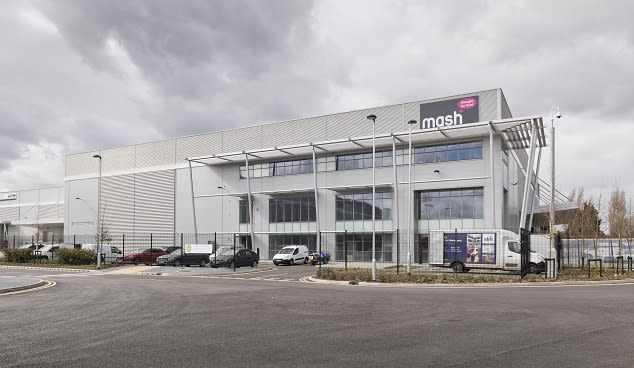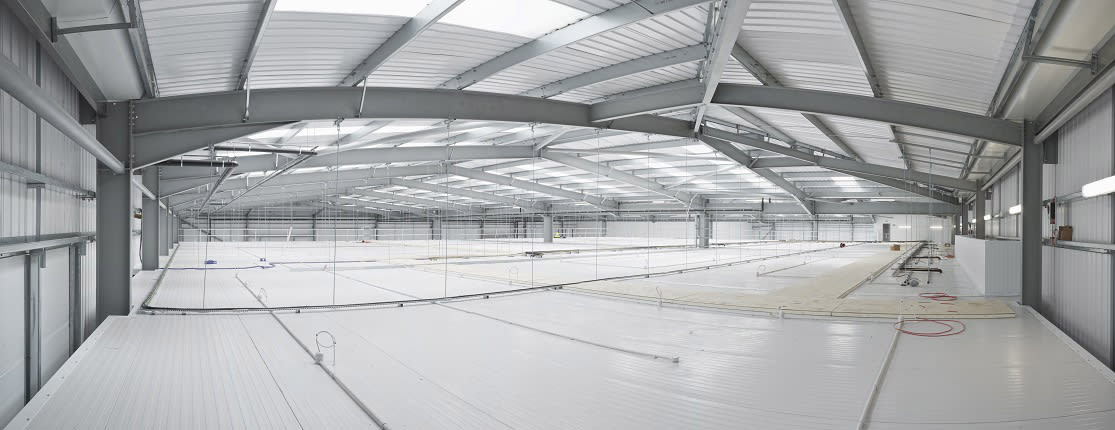- Client: Mash Purveyors
- Lead Contractor: Howard Russell Construction
- BIM Tools: Autodesk Revit, Tekla and Tekla BIM Sight
If you’re a contractor that has reached a certain level of BIM awareness and are ready to make the leap to a fully digitised project, what kind of project do you choose? This was the problem faced by Howard Russell Construction, an SME based in Northumberland which undertakes work across the UK. It had used elements of BIM on five jobs, and wanted to try out a fully-fledged version.
It picked a small scheme in Park Royal, west London – a £3m cold storage centre for food distributor Mash Purveyors. The client’s lease meant that missing the end date would have unpleasant consequences, the time allowed was a mere four months and the contractor came on board fairly late in the day.
But the client was a newcomer to construction with no expectations that BIM would be used, and this gave Howard Russell a certain measure of freedom in how it developed the model, according to Craig Muldoon, the contractor’s preconstruction manager and BIM champion.
Never mind the acronyms
Muldoon had spent a couple of years building up to this full-scale BIM-enabled job. To begin with, he says, the experience was akin to learning a foreign language – the number of unfamiliar concepts expressed in terms of abbreviations and acronyms was, to say the least, daunting. After a certain amount of research, Muldoon found that it began to make sense.
“The whole point of BIM is collaboration. They talk about the technology but it’s not really about that; if you strip it down to what it is, it’s common sense – it’s a load of people who know what they’re doing sitting around the table talking.”

The new centre at Park Royal, west London
And as he began to see it in that light, it became clear that individual firms had a certain amount of latitude in how they took up models, how they could adapt the model to their needs, and how they could adapt themselves to the needs of the model.
For example, rather than using a thrid partycloud-based hosting service, Muldoon realised that a simple file system could be adapted to do the job of the Common Data Environment. “What we didn’t want to do was to introduce something into the company that people would find daunting, and would put them off BIM,” he says. “I looked at what was required and we saw that we could use a file system on the server with the ShareFile utility to control what people could do with the files.”
And certain procedures that BIM “theory” says the contractor ought to do were dispensed with. “There’s a lot of stuff that we’ve found that is a little bit OTT. On the 4D side, we’ve taken that principle of planning and using the software to aid that but there’s nothing that says you need to link your model to the programme and do live build simulations because you just think, well what’s the point?”
Formalising common sense
And when it came to making software formats interoperable, this could be done with the kind of professional forward planning that contractors should be undertaking in any case, BIM or no BIM. “We have a kick-off meeting at the start of the job and part of that is developing the BIM execution plan, where everyone says what software they’re using and what exchange formats are required,” says Muldoon.
“It goes back to BIM being common sense and people talking to each other. It’s a more formal way of doing what we did anyway, but what frightened us was that when you talk to clients and subcontractors or designers you find a lot of them fly by the seat of their pants a bit, so they’ll have to adapt to the kind of professional discipline that BIM imposes.”
At the same time, the contractor had to make changes in the light of experience. For one thing the file system as it was set up had some flaws: suppliers and designers uploaded files with the wrong naming convention in the wrong place, and this could have caused problems. In future jobs, all uploads will go into a project inbox, so that a dedicated information manager can check them and put them in the right place.

For another, subcontractors were not expected to work in the 3D environment. Muldoon says: “We do not want to isolate our supply chain – we’ve got a database of subcontractors that we know can perform to the standards that we want, so if it’s a project where the client’s expecting COBie data, we look to employ someone who can do the design role as an additional service or have a standalone BIM information manager who will take data sheets and 2D info from subcontractors and put it into model.”
The payoff
This pragmatic approach to BIM paid dividends for the client when the job was on site. The work was completed on time, and tricky areas such the construction of an insulated suspended insulated ceiling went off without a single clash. This was a particularly difficult area, because metal hangers and the heavy refrigeration equipment had to marry perfectly.
There was also an additional benefit for the client: although Howard Russell joined the project at too late a stage to have time to plan for the FM work after handover, it took the decision to fit all the equipment with data points so that the client could retrospectively fit a smart management system to minimise operating costs.
Both sides were happy with the outcome, but Muldoon believes that clients could get further benefit out of BIM by revising the way it goes about procurement. Muldoon says: “With BIM, we can put in a keener price because we don’t have to build in as much risk.
“But the big thing is that the contractor needs to get on board earlier, whether through negotiation or two-stage tenders. It concerns us a little bit that people want all the benefits of BIM but they still going to have that old-school feeling that you’ve got to tender to get the best price – and let’s keep the contractor out until the last minute.”
He argues that this defeats the object of using a model in the first place. “We’re now integral to the design team, so I think the way procurement is happening will have to change. Yes, we may make a couple of per cent more than what we normally would but the solution would probably be about 10 or 15% more efficient.”

The whole point of BIM is collaboration. They talk about the technology but it’s not really about that; if you strip it down to what it is, it’s common sense – it’s a load of people who know what they’re doing sitting around the table talking.– Craig Muldoon, preconstruction manager, Howard Russell
Comments
Comments are closed.












This is what BIM should be……..it is about common sense.